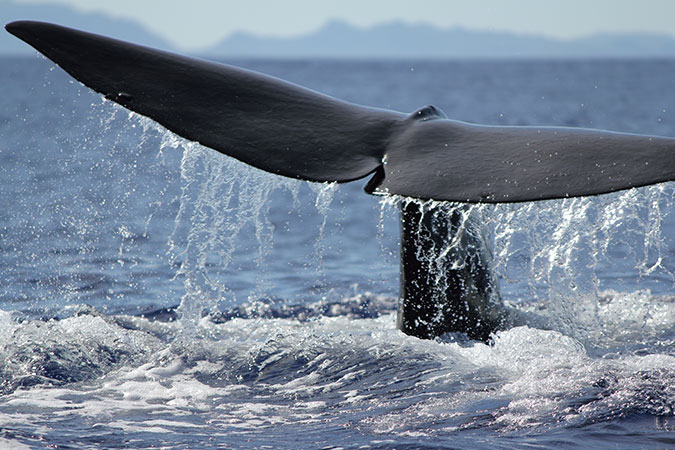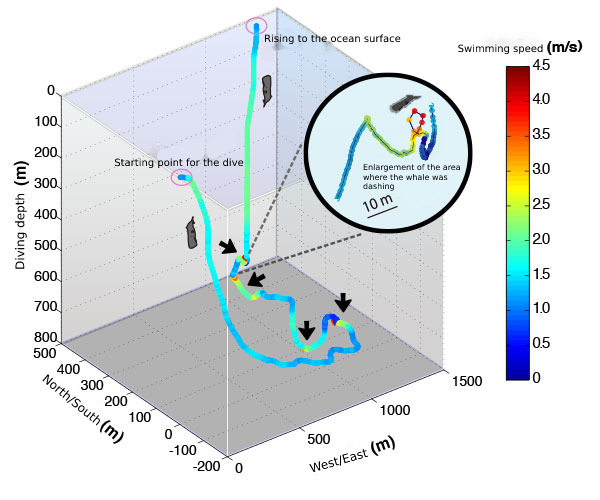Monitoring the surprising lifestyle of whales With a bio-logging method using suction cups

A collection of research and educational activities related to the birthplace of all life
The year 2021 marks the start of the United Nations Decade of Ocean Science for Sustainable Development, a major campaign to advance the science of the ocean, which is the birthplace of all life and sustains the lives of organisms on Earth. This year, the University of Tokyo welcomed as its new president a scientist who has lived and worked with the ocean. From engineering, physics and biology to agriculture, law and economics, we introduce UTokyo’s ocean research and marine education activities as illustrated by examples from various fields.
| Marine Mammalogy |
Monitoring the surprising lifestyle of whales
With a bio-logging method using suction cups
 By Kagari Aoki By Kagari AokiResearch Associate, Atmosphere and Ocean Research Institute http://fishecol.aori.u-tokyo.ac.jp/aoki/ |
Bio-logging is a research method for looking into the habits of animals by attaching a recording device to their bodies. When it comes to huge whales, however, catching them and attaching the devices to their bodies is difficult. To solve this problem, Research Associate Kagari Aoki has been using suction cups to attach the logging devices, thereby monitoring whale behavior previously unknown to anyone. Her goal is to foster the creation of a new understanding of how animals coexist with humans.

Have you ever seen a dolphin or a whale in the ocean? When I ask this question during my lectures or on other occasions, I rarely see a hand going up. Nearly half of the approximately 90 species of cetaceans live in the waters around Japan, but their existence is far removed from our daily lives.

Sperm whales are gigantic whales, with males of the species having a body length measuring around 16 meters. They are divers, plunging to a depth of over 1,000 meters. The whales are also at the top of the food chain in the deep-sea ecosystem, eating several hundred kilograms to one ton of cephalopods and fish per day. They float like logs on the surface of the water to catch their breath and then lift their tail fins high to dive into the deep sea. Sperm whales are said to fight with giant squids (although it’s a fight to death for the squids), but no one has yet to witness such a scene.
So, what are sperm whales doing in the deep sea? Driven by the urge to find out the answer, I have been conducting research using a technique called bio-logging, in which activity-recording devices are attached to animals.

A three-dimensional reproduction of a sperm whale’s active foraging behavior in the middle and deep layers of the ocean, as revealed by a recorder. (The figure indicates a single dive.) The parts with arrows indicate sharp turns while dashing.
Bio-logging is a research method invented in the 1980s to obtain information about animals’ behavior, physiology and habitat by attaching small data loggers to their bodies. The term “bio-logging” actually originated in Japan. It has gradually spread throughout society, and nowadays the term even appears in textbooks for elementary and junior high school students.
The method is used for studies on various taxonomic groups, including fish, reptiles, birds and mammals, in areas ranging from the polar regions to the tropics. The intention of such studies is not only to shed light on animal ecology but also to conduct oceanographic observation.
In order to use the bio-logging method, we need to catch animals and attach the data loggers. But since it’s impossible to catch huge animals like sperm whales alive, I developed a device to attach the recorder to their bodies using a suction cup. The use of this equipment enabled us to capture their predatory behaviors such as dashing and making sharp turns as well as the mysterious way they sleep in a vertical position just below the ocean’s surface.
Recently, I have been working to develop a method to study the nutritional condition of animals without harming them. We can now estimate the body condition of cetaceans based on the way they swim, and monitor how they get fat in waters with abundant food, as well as changes caused by their reproductive status, such as pregnancy and lactation. I would also like to develop tools such as a wearable device that can monitor the activity and heart rate of cetaceans, so that we can immediately assess the effects of human activities on them.
As the human impact on marine ecosystems has become enormous today, many animals and other organisms that live in the ocean, such as marine mammals, sea turtles, seabirds and fish, face critical situations. The ocean is a common asset for all humankind, but only when such “ocean citizens” are able to lead healthy lives can people enjoy its blessings.
Bio-logging research enables us to look at the lives of marine animals from their perspective. Through data obtained from the animals’ points of view, I’m hoping to create a system that will allow humans to feel closer to marine animals. With new ways to coexist and interact with marine animals, I believe that people will see them as more than simply pests, food sources or something to put on display.
* This article was originally printed in Tansei 43 (Japanese language only). All information in this article is as of September 2021.






